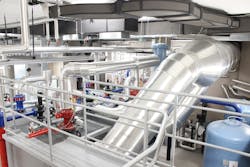Quiz Corner: Steam flow measurement with vortex shedding flowmeter
A vortex shedding flowmeter is used to measure steam flow leaving a boiler house. The flow measurement is relatively steady until a sudden electrical outage occurs and trips all of the boilers. The operators scramble and finally restart the boilers approximately 15 minutes later. How do you expect the steam flow measurement to react between the trip and the restart?
A. Flow steadily drops
B. Flow rises for a few minutes and then drops
C. Flow drops for a few minutes and then rises
D. Flow steadily rises
Logic would suggest that the steam flow will drop steadily after the trip until the boilers restart. After all, how can the steam flow rise if there is no fire in the boiler? Implicit in this analysis is that the term "steam flow" refers to the mass flow of steam. However, the vortex shedding flowmeter measures the velocity of the steam — not mass flow as may be suggested by its display in pounds or metric tons per hour.
Steam generation will steadily drop after the boilers trip, so the steam header pressure will drop as the steam in the piping system is consumed. The drop in header pressure causes a given mass of generated steam to be larger than the same mass would be at its normal operating pressure. The net result is that the volume of the steam generated is temporarily so large for a given mass that the flow measurement actually increases before peaking and then dropping off. Answer B is correct.
Additional complicating factors
Implementing a flow computer to compensate for pressure would improve accuracy during operation and provide a better representation of steam flow following a trip.
David W. Spitzer is a principal at Spitzer and Boyes, LLC, which offers engineering, focused market research, writing/editing white papers, strategic marketing consulting, distribution consulting, seminars and expert witness services for manufacturing and automation companies. Spitzer has written more than 400 technical articles and 10 books about flow measurement, instrumentation and process control. He can be reached at 845-623-1830 or via spitzerandboyes.com.
About the Author
David W. Spitzer
David W Spitzer’s new book Global Climate Change: A Clear Explanation and Pathway to Mitigation (Amazon.com) adds to his over 500 technical articles and 10 books on flow measurement, instrumentation, process control and variable speed drives. David offers consulting services and keynote speeches, writes/edits white papers, presents seminars, and provides expert witness services at Spitzer and Boyes LLC (spitzerandboyes.com or +1.845.623.1830).

